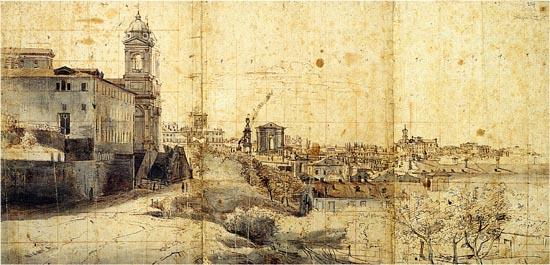KARL FRIEDRICH SCHINKEL, Rome from my apartment
Francisco Martínez Mindeguía
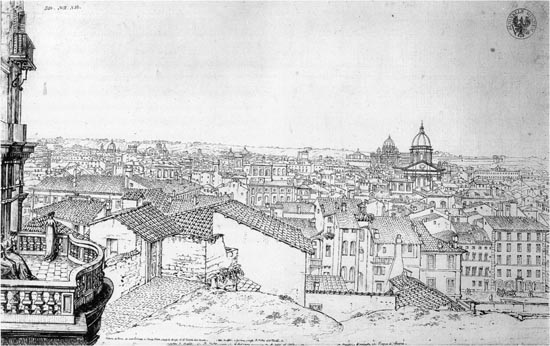 |
In the composition of Schinkel, relatively conventional, it stands out in the left side the extreme of a building, with a balcony in which they are three young women. One of them is of backs, observing the city. She do not sign of action, she seems to be paralyzed in front of the vision of Rome, which contemplates in silence, isolated from her two companions. This character shares our orientation and sees what we see. Situated of remembers some of the characteristic compositions of Caspar David Friedrich, with its characters paralyzed in front of the contemplation of the landscape, isolated and in silence; characters without action nor explicit contents that, for this reason, we finish identifying them with the landscape, with the author and with us: they are “the spiritual centre, the conscious element of landscape” (Beenken 1938, p. 175). |
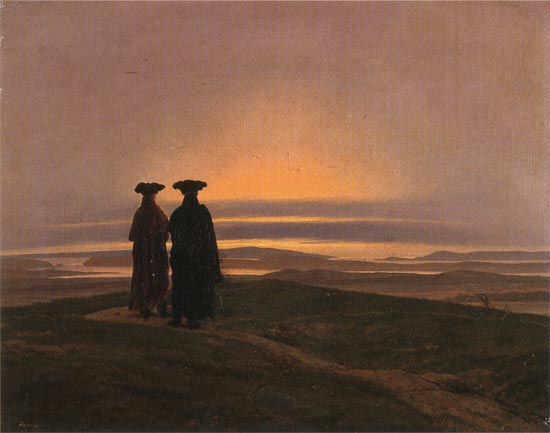 |
2. C.D.Friedrich, Paisaje al atardecer con dos hombres, c.1830-1835 In words of Rewald (2001, p. 30), ‘these characters transmit the Romantic sense of the yearging for what is unreachable’ or, in that of Schinkel (Wolzogen 1863), ‘a presentiment of infinity’ or of ‘that which cannot be presented’. As in the pictures of Friedrich, is the own Schinkel the represented in this figure of backs, an self-representation that was not strange in the art history (already Rafael was included between the characters of The School of Athens), but was less usual in the landscapes. |
 |
The others two women are sitting and neither show signs of action. In their taciturn attitude, they remember the image of the artist overwhelmed by the greatness of the ruins of Rome, which Johann Heinrich Fuseli painted after his stay in the city, and which has been interpreted as a symbolic self-portrait, in a sublime confrontation of the artist with the Classic past: the despair of the artist, that recognizes the disproportion between his smallness and the greatness of the antiquity, defeated in front of the magnitude of what surrounds him, which he is seen unable to cover and understand. |
|
| 3. H. Fuseli, The Artist’s Despair before the Greatness of the Antique Ruins, c.1778-1780 |
Possibly Schinkel did not invent a new way to represent the city and not even this apparent originality is it in reality. Schinkel used well-known models in the Roman area for, in a subtle way, to represent the city and the feeling that it causes him. Not only it is the city what Schinkel draws, but the romantic vision that he has of it. If the artists of the Renaissance understood the perspective as the vision through the window, in which the painter "brings" the space that he sees to the other side towards the glass, Schinkel adds the projection of himself towards that glass. Two projections in opposite senses , melting on the same plane. If as it said Thomas Browne (1645, part 2, sec. 11), ‘the world that I regard is myself, it is the microcosm of my own frame that I cast mine eye on’, we are also the drawing that we do of it. The drawing always contains a projection of the draftsman and it would be interesting to analyze the ways in how this self-projection is produced, in how how the artist leaves traces that indicate that he was or had been there. This article tries to deepen thus into this drawing and into others that Schinkel and others draftsmen made with a similar result. The reference of the three women in the balcony of the drawing and the text of the title are not only rhetorical resources. The title indicates the place from which really the drawing was made, a building of the east side of Via Sistina (before called Felice) in which Schinkel had his housing in Rome. In a letter that Schinkel writes from Rome, he said that 'I have found house among the works of art. From what is high of the mount Pincio my window dominates the western part of the city. Thousands of buildings finished off by domes and towers extend at my feet. It remains in the distance S. Pietro and the Vatican and, behind, plane, the Gianicolo crowned by the pinewood of villa Pamphili. My door gives almost on the extraordinary stairs of the church of Santissima Trinità dei Monti, that drives from the summit up to the Piazza di Spagna that it is in the feet of the hill'. This is the image that Schinkel sees from his housing and the one that he reproduces in the drawing. |
 |
Neither the balcony is a fiction: it is the north end of the building in which at present it is the headquarters of the Bibliotheca Hertziana, between the streets Sistina and Gregoriana; the building that at first was the house and study of the painter Federico Zuccari, built by him in 1590 (fig. 4). The same building in which afterwards there lived the queen Casimira of Poland (between 1703 and 1714), which in 1711 commissioned Filippo Juvarrato add the balcony that appears in the drawing. The building in which afterwards artists as Pietro Bracci, Joshua Reynolds, Jacques Louis David, Christian Reinhardt and Joseph Anton Koch were lodged, as well as the experts Johann Joachim Winckelmann and Carl Ludwig Fernow. Perhaps, they were these last two figures those contributed a significant value to this balcony, that allowed personalizingin him the feeling of ecstasy and melancholy of the own Schinkel. The image is real, his housing was there, the balcony is real, the feeling of his characters also, and it is his. | |
| 4. Palazzeto Zucari, Roma |
Schinkel went to Italy attracted by the classic world, as so many German, English, French or Spanish artists did, and to Rome as the obligatory goal, essential of the Grand Tour, the centre and the reference of the classic cultural tradition. A trip that was the evocation of a myth that was experienced with the memory of the classic ones, of the Latin poets, of the legends and of the images that painters as Piranesi had given of the former Rome (Milani 2001, p.70). But the architecture did not interest Schinkel as much as the landscape did; a landscape that always contained architecture and an architecture that was always in a landscape, and never isolated; it was in the landscape where he discovered the 'atmosphere of the classicism' (Zoeggeler, en Riemann 1989, p. 29). The feeling for the landscape and the nature had reappeared, in the second half of the seicento, as an opposition to the mathematical logical spirit of the previous centuries and as a revolution of the senses and of the sight particularly. It was a knowledge to see that it affected the aesthetics, the understanding and the morality, which it led to a sort of interior contemplation. It was the nature seen as an aesthetic object, the landscape as the nature that was revealed aesthetically (Simmel 1985), a spectacle that claimed a sincere one and astounded participation of the observer. In this situation, the appeal of Rome also lived in its spectacular nature, in the particular light that gave to its monuments, in the mixture among the nature, that invaded the citizen spaces, and the ruins of a glorious history, in the contrast among the pastoral scenarios that opened out unexpectedly to the animated worldly nature of the streets (Billi 1997, p. 334). The interest of Schinkel in the landscape had to lead to him to appreciate the work of the Dutch Gaspar van Wittel (1653-1736), resident in Rome since 1675, nationalized Italian, known as Gaspare Vanvitelli, precursor of the vedutismo of the settecento, of the genre that afterwards would develop Luca Carlevarijs, Giovanni Paolo Panini, Canaletto and Bernardo Bellotto (Briganti 1996), and point of reference for the artists of the Grand Tour. However, it is not clear if Schinkel could see the drawing of Vanvitelli known as Veduta panoramica di Rome, sinceit it did not get to be converted in painting, and that during some time was considered as a view from Trinità dei Monti . |
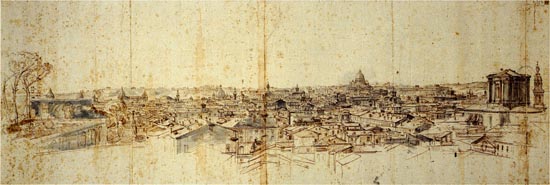 |
5.G. Vanvitelli, Veduta panoramica di Roma, s.a. This drawing, made really from the gardens of the Quirinalle, shows Rome in the same way and with a framing similar to the drawing of Schinkel. It is a drawing of almost four linear meters one, which covers a angle of vision of about 120 degrees. The parallelism with Vanvitelli is repeated in other drawings of Schinkel, as the titled Players with the Spanish Steps and Trinità dei Monti, Rome, at the end. |
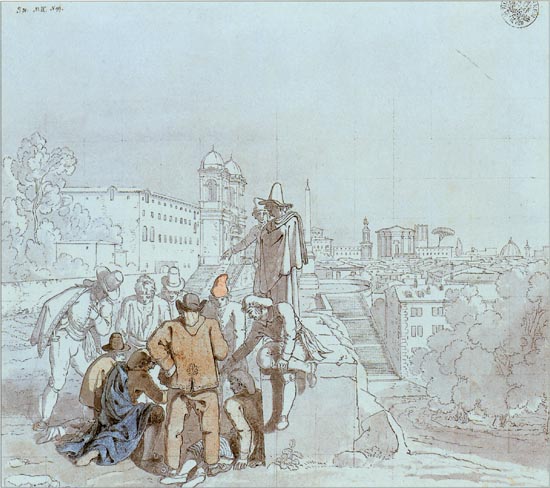 |
6. K.F. Schinkel, Jugadores con la Scala di Spagna y S. Trinità dei Monti, Roma, al fondo, c. 1803-1804 The drawing is similar in the point of view and the framing to the one that Vanvitelli did of this same place and of the one that is preserved by four painted versions, one of them of little before 1713. |
|
| 7. G. Vanvitelli, Vista panorámica de Roma con Trinità dei Monti,1681 |
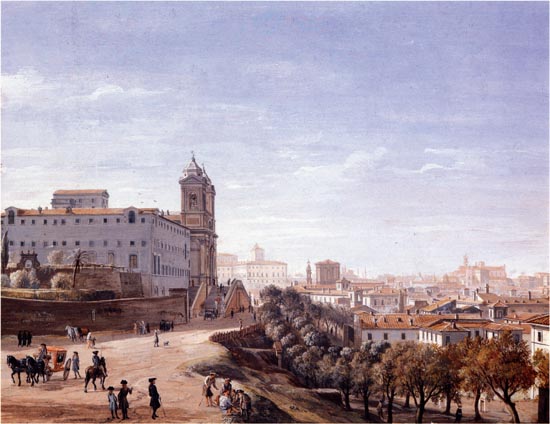 |
8. G. Vanvitelli, Vista panorámica con Trinità dei Monti, 1713 The parallelism with this last picture is more evident than with the drawing, since the subject of the players appears also in it, in the central inferior part, although without so much importance. If Schinkel depart from the drawing of Vannitelli, it is evident that he completely transformed it, making that an anecdotal subject take up the center of the image and leaving the city as scenographic background in which all this happens. The players are the center of the scene but, skilfully, none of them get to hide the identifiable elements of the urban landscape: as in the drawing of Vanvitelli, it is recognized the block of the Quirinale, to the right of those that observe the game at the top of the wall, and more to the right, the campanile and the dome of Sant'Andrea delle Fratte. The incorporation of characters in the foreground of the landscapes, was an usual resource in the pictures of Claude Lorrain, indisputable referent in the European landscaping of the 17th, 18th and 19h centuries, capable of loading the Sacred Writings or the pastoral subjects with references to Virgilio, Ovidio, in pictures whose real value was the landscape: an idealized landscape that talked 'at the same time to the eyes and the mind' (Nicholson, in Solkin 2010, p. 60). It was also an usual resource in the work of the engravers of the north of Europe (Bodart 1970). However, the use of this resource by Schinkel, in the drawings that have been seen, has a more precise referent in the work of Lieven Cruyl, a Flemish draftsman and engraver of Gante, which worked in Rome between 1664 and 1674, later in Florence (1672), Naples (1673), Venice (1676) and Paris (1680-1687), and of which are known a certain activity as architect. He was influential in the first works of Vanvitelli (Zwollo1971), with works of a great topographical accuracy and high points of view, as the drawings that are preserved of Venice, of the Roman Forum or in others of biblical subject (Eisler 1988). The drawings that did in Rome, some of them published in Prospectus Locorum Urbis Romae Insignium, in 1666, are mainly urban views characterized by their high accuracy, useful even today in the historical studies, for the great span angle that applies in his perspectives, that can arrive to cover 200 or 300 degrees, and for their capacity for describing the atmospheres, so much urban as social. Regarding the initial drawing of Schinkel, the reason to mention it is that one of his features consisted in situating characters in the foreground of the image, also on a balcony or terrace roof, with the aim of giving depth, similarly to as it appears in the drawing of Schinkel. |
.jpg) |
9. L. Cruyl, Prospetto dell Chiesa de S. Ignatio, c.1664-1666 In many cases even, these characters appear of backs and with a drawing board, in action of drawing in it. |
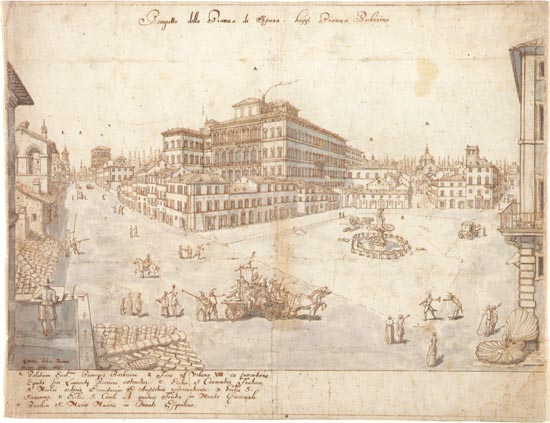 |
10. L. Cruyl, Prospetto della Piazza di Sforza, hoggi Piazza Barberino, c.1664-1666 The identification with the drawing of Schinkel is evident and does not seem to pose doubts. As it happened with the drawings of Vanvitelli, a resource that the landscapers used to increase the sensation of distance, which Cruyl extended with his "self-representation", was taken advantage of by Schinkel to reflect the feeling that the vision of Rome cause him. It is not strange that Schinkel knew the work of Cruyl since the engraving was one of the main media of the Roman culture and an important industry that even was alive in the 19th century. Indication of this importance is the text that Goethe (1816) wrote in the diary of his stay in Rome, in 1786: 'I am so snatched by Michelangelo, that not even I find liking in the nature after having admired it, since I can not contemplate it with eyes as big as his. If at least there were a means of recording his images for me in my soul! But I carry with me the more engravings and drawings I have been able to obtain of his works'. Before the diffusion of the photography, this was the best way of taking the wonders of Rome of turn home, if the budget did not allow to buy pictures, sculptures or archaeological remains, as they did many Englishmen of the Grand Tour. This and the great demand for experts, artists and dilettanti that requested them, gave rise to the important trade of the engraving in Rome, of the 17th, 18th and 19th centuries, and allowed the work, first of Israël Silvestre, Lieven Cruyl, Giovanni Battista Falda and Domenico Barriere, and later of Gaspare Vanvitelli, that elevated the topographical view to a new artistic dignity (Briganti 1996, p. 83). Of a way or another, they all drew the city to give it to the foreigners in the form of maps, next views either distant, in many cases, similar, recycled or augmented. Many of the foreigners were students or professionals that were added to the residents in Rome drawing, recycling or extending the engravings and drawings previous. One of them was Schinkel, recycling and extending the engravings and drawings of Cruyl and Vanvitelli. The coincidence among the three artists is repeated also in some other of the drawings that Schinkel made in Rome. It is especially interesting the one that did of the Quirinale Palace, from an interior in backlighting that possibly was also his own apartment. |
 |
11. K,F, Schinkel, Vista panorámica de Roma, con tejados en el primer término, c.1803-1804 As in the drawings of Cruyl, the dark frame of the building is the place in which it is Schinkel, and us with him; the city is seen in its interior as the scenography of a theater and the frame is the box. As in the image with which we have started, the city is shown to us as an esthetic object, a spectacle that has to be contemplated, a theatre whose action is the history, the literature and the time, which varies with the situation of the observer and with his implication. In this scenography the buildings have a character determined by their representativeness, their size, their situation and the history that accompanies them; they are simple or noble, vulgar or cultivated, religious, politicians or domestic, and their distribution is the one that defines the limits of the scenic space and the place of the action. With this same framing, there is another drawing of Vanvitelli, with a point of view near to that of Schinkel. |
 |
12. G. Vanvitelli, Vista del Quirinale, s.a. |
 |
13. L. Cruyl, Prospetto del Anfiteatro di Vespasiano e Tito e del Arco di Constantino, c.1664-1666 The framing of the building is similar and the backlighting also, but in Schinkel the self-representation is subtler, when dispensing with the character. It is the frame the one that indicates from where the drawing was done and where its author was; the city that it is seen and who sees it, as if they were two drawings to both sides of the same window. The one that travels sees with the eyes predisposed by all what of that place he has seen, read or heard. In the same way that the guides repeat in greater or smaller measure the guides written previously (Ebano 1989), the one who draws repeats what has been drawn previously. We see with the eyes that saw before and we draw, recycle or extend drawings that somebody drew before. We continue the drawings that others have started and others will continue, maybe, those that we make. It is difficult to situate the beginning of a drawing and it is impossible to know when a drawing finishes: when will it leave to be the beginning of new drawings. In this endless process, I want to finish with what would be a continuation of the last drawing of Schinkel, Vanvitelli and Cruyl, in another of Otto Wagner. It is the perspective that he did for the competition of the Berlin Cathedral, of 1891, the plan n. 5 of his proposal. |
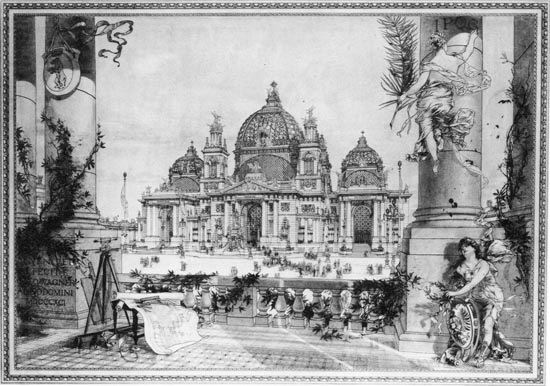 |
14. O. Wagner, Proyecto para la catedral de Berlín, 1891 A project that had to occupy the east side of the square that Schinkel had foreseen in front of the Altes Museum. To resolve the asymmetry of the situation, Wagner proposes the construction, at the other side of the square, of a monumental colonnade, of the same length that the building of the cathedral and does this perspective from that portico. As in the Schinkel’s drawing of the Quirinale, the space appears in backlighting, but Wagner represents himself in an explicit way. Following the tradition of the engravings, he leaves evidence of who is its author: "Invenit et fecit Otto Wagner Anno Domini MDCCCXCI" and leaves the marks of his recent presence: the plan of the cathedral, partially unrolled on a stool, the set square and a compass on it, the drawing board with a T-square, the tape measure, a sight on a tripod, and the cases of where these utensils have come out. Again the box, the theater (of theatron-theastai-look) and the mark of its author, which now is a technician: Wagner has been here, finishing the project and the cathedral. |
References:
- Beenken, Hermann, ‘Caspar David Friedrich’, The Burlington Magazine, 421, 1938, p. 175.
-
Billi, Mirella, 1997, ‘La Roma del Grand Tour. Memorie e immagini dei viaggiatori inglesi nel '700’, Studi romani, 45, p. 334.
-
Bodart, Didier, 1970, Les peintres des pays-bas méridionaux et de la principauté de Liège à Rome au XVIIème siècle, Institut Historique Belge de Rome, Brussels and Rome.
-
Briganti, Giuliano, 1996, Gaspar van Wittel, Electa, Milan.
-
Ebano, Gabriella, 1989, ‘Le guide di Roma del Settecento e la loro influenza sulla letteratura di viaggio’, Studi romani, 37, 3/4, pp. 329-335.
-
Eisler, Colin, 1988, ‘Power to Europe’s Chosen Peoples. A New Maccabean Page for Louis XIV by Lievin Cruyl’, Artibus et Historiae, 9, 17, pp. 31-38.
-
Forster, Kurt W., 1994, ‘‘Only Things that Stir the Imagination’. Schinkel as a Scenographer’ (Zukowsky 1994).
-
Fréart de Chantelou, Paul, 1665, Diario del viaje del caballero Bernini a Francia, (cited ed. 1986, Dirección General de Bellas Artes y Archivos, Madrid, p. 81).
-
Goethe, Johann W., 1816, Viaje a Italia, (cited ed. 2009, Zeta, Barcelona).
-
Milani, Raffaele, 2001, L’arte del paesaggio, Il Mulino, Bologna, p. 70.
-
Riemann, Gottfried, et al., 1989, 1781-1841 Schinkel l’architetto del principe, Marsilio Editori, Venice.
-
Simmel, Georg, 1985, Il volto e il ritratto. Saggi sull’arte, Il Mulino, Bologna.
-
Solkin, David, 2010, ed., Turner y los Maestros, Museo Nacional del Prado, Madrid, p. 60.
-
Szambien, Werner, 1989, Schinkel, Akal Arquitectura, Madrid.
-
Wolzogen, Alfred von, 1863, ed., Aus Schinkels Nachlass. Reisetagebücher, Briefe und Aphorismen, vol. 3, Decker, Berlin.
-
Zwollo, An, 1971, ‘Roman views at the Farnesina’, The Burllington Magazine, 821, p. 484 y 486.
Origin of the images:
1, 6, 11 - Zukowsky, John, 1994, ed., Karl Friedrich Schinkel. The Drama of Architecture, The Art Institute of Chicago, Tübingen, p. 19, 104 y 103.
2 - Sabine Rewald, Caspar David Friedrich: Moonwatchers, New York, The Metropolitan Museum of Art, 2001, p. 42.
5, 7, 8, 12 - Benzi, Fabio, 2002, et al., Gaspare Vanvitelli e le origini del vedutismo, Viviani Editori, Rome, cat D9, cat. D1 y p. 81.
9, 10, 13 - Connors, Joseph, and Rice, Louise, 1991, Specchio di Roma barocca. Una guida inédita del XVII secolo, Edizioni dell’Elefante, Rome, p. 185, p. 169 y 195.
14 - Graf, Otto Antonia, 1985, Otto Wagner. Das Werk des Architekten. 1860-1902, v. 1, Hermann Böhlaus, Vienna, p. 83.
Recommended bibliography:
- Ashby, Thomas, 1923, ‘Lieven Cruyl e le sue vedute di Roma (1664-1670)’, Atti della Pontificia Accademia Romana di Archeologia, Serie III, Memorie, vol I, part I, Tip. Poliglotta Vaticana, Rome, pp. 221-229.
-
Benzi, Fabio, 2002, et al., Gaspare Vanvitelli e le origini del vedutismo, Viviani Editori, Rome.
-
Börsch-Supan, Helmut, 1972, ‘Caspar David Friedrich’s Landscapes with Self-Portraits’, The Burlington Magazine, 834, p. 620-630.
-
Browne, Thomas, 1645, Religio Medici.
-
Connors, Joseph, and Jatta, Barbara, 1989, Vedute romane di Lievin Cruyl. Paessaggio urbano sotto Alessandro VII, American Academy in Rome, Rome.
-
Connors, Joseph, y Rice, Louise, 1991, Specchio di Roma barocca. Una guida inédita del XVII secolo, Edizioni dell’Elefante, Rome.
-
Connors, Joseph, 1998, introducción, Francesco Borromini. Opus Architectonicum, Edizioni Il Polifolio, Milan.
-
Egger, Hermann, 1927, ‘Lieven Cruyl’s Römische Veduten‘, en The Mededeelingen van het Nederlandsch Historisch Instituut te Rome, VII, The Hague.
-
Graf, Otto Antonia, 1985, Otto Wagner. Das Werk des Architekten. 1860-1902, v. 1, Hermann Böhlaus, Vienna.
-
Holm, Lorens, 1992, ‘Reading Through the Mirror: Brunelleschi, Lacan, Le Corbusier. The Invention of Perspective and the Post_Freudian Eye/I’, Assemblage, 18.
-
Jatta, Barbara, 1992, Lievin Cruyl e la sua opera grafica. Un artista fiammingo nell'Italia del Seicento, Institut Historique Belge de Rome, Brussels and Rome.
-
Pietrangeli, Carlo, 1972, ‘Vedute romane di Lievin Cruyl al Museo di Roma’, Bollettino dei Musei di Roma, 19, pp. 7-21.
-
Rewald, Sabine, 2001, Caspar David Friedrich: Moonwatchers, The Metropolitan Museum of Art, New York.
-
Schiff, Gert, 1973, Johann Heinrich Füssli 1741-1825, Werner Hofman, Zurich.
-
Walton, G., 1981, ‘Lievin Cruyl: The Works for Versailles’, Art the Ape of Nature, New York, pp. 425-437.
-
Zukowsky, John, 1994, ed., Karl Friedrich Schinkel. The Drama of Architecture, The Art Institute of Chicago, Tübingen.
© of the texts Francisco Martínez Mindeguía
This article is adapted from the same author´s article published under the title"Vista desde mi alojamiento" (View from my apartment), in the EGA expresión gráfica arquitectónica magazin, 17, Valencia 2010, pp. 90-103.
>> Back to the top of the page
>> Back to Dibujos Ejemplares de Arquitectura
